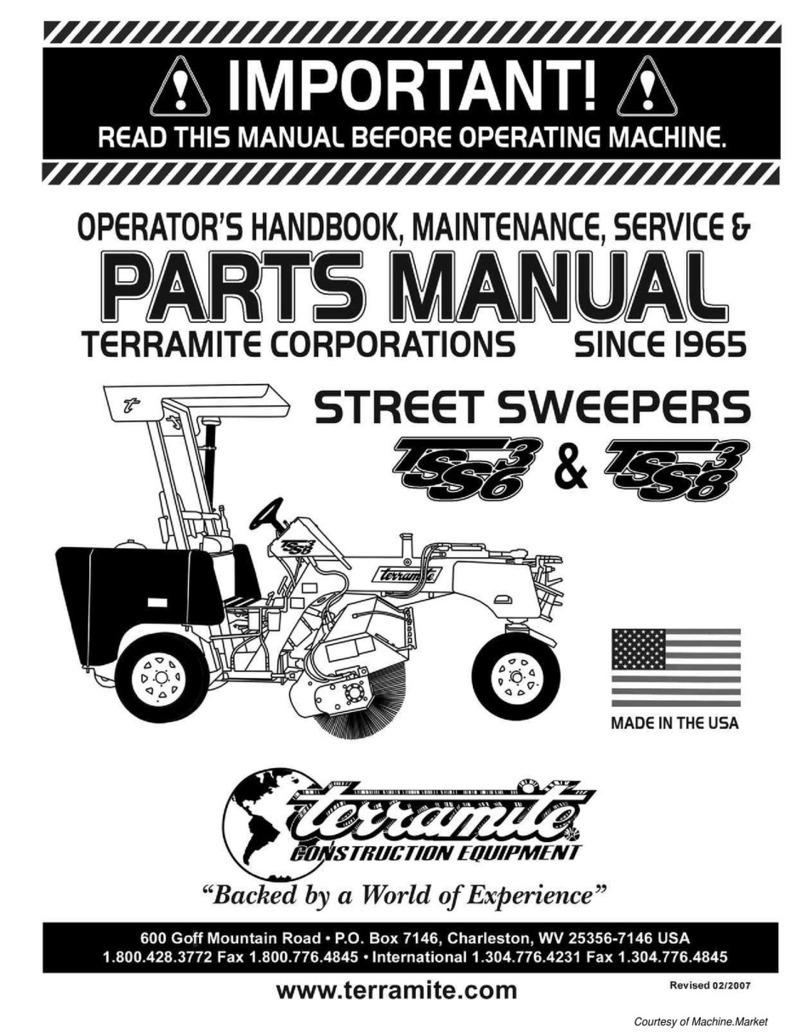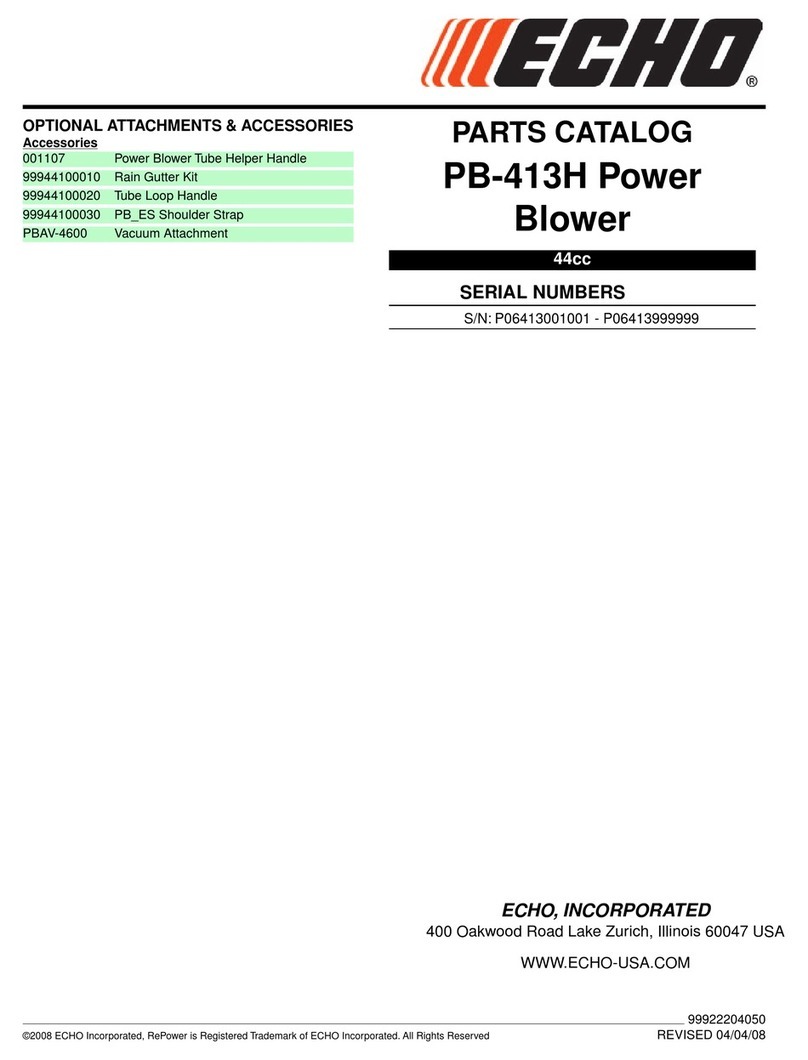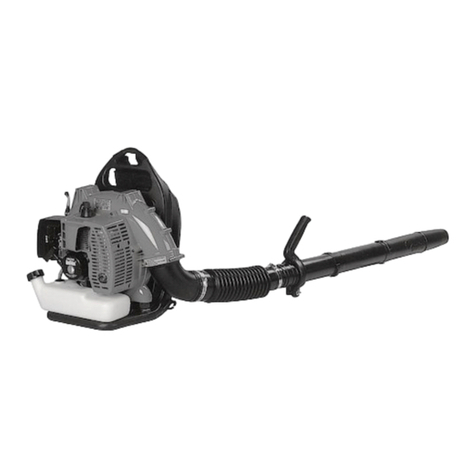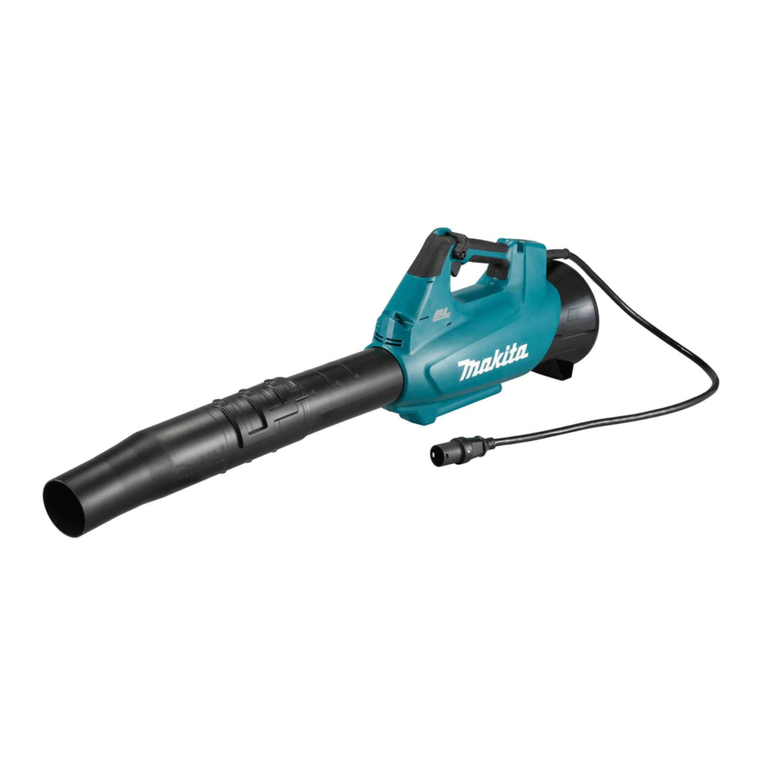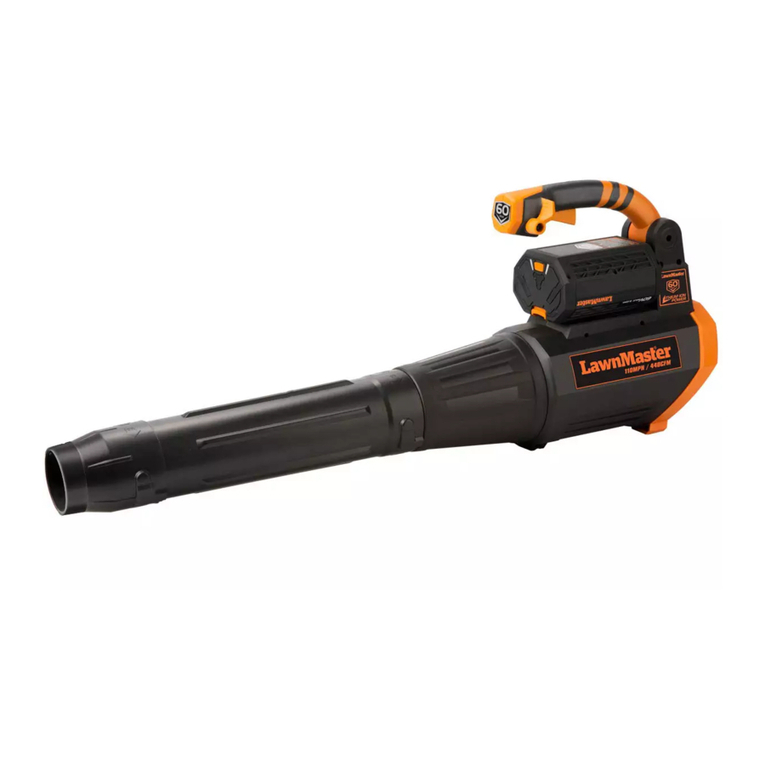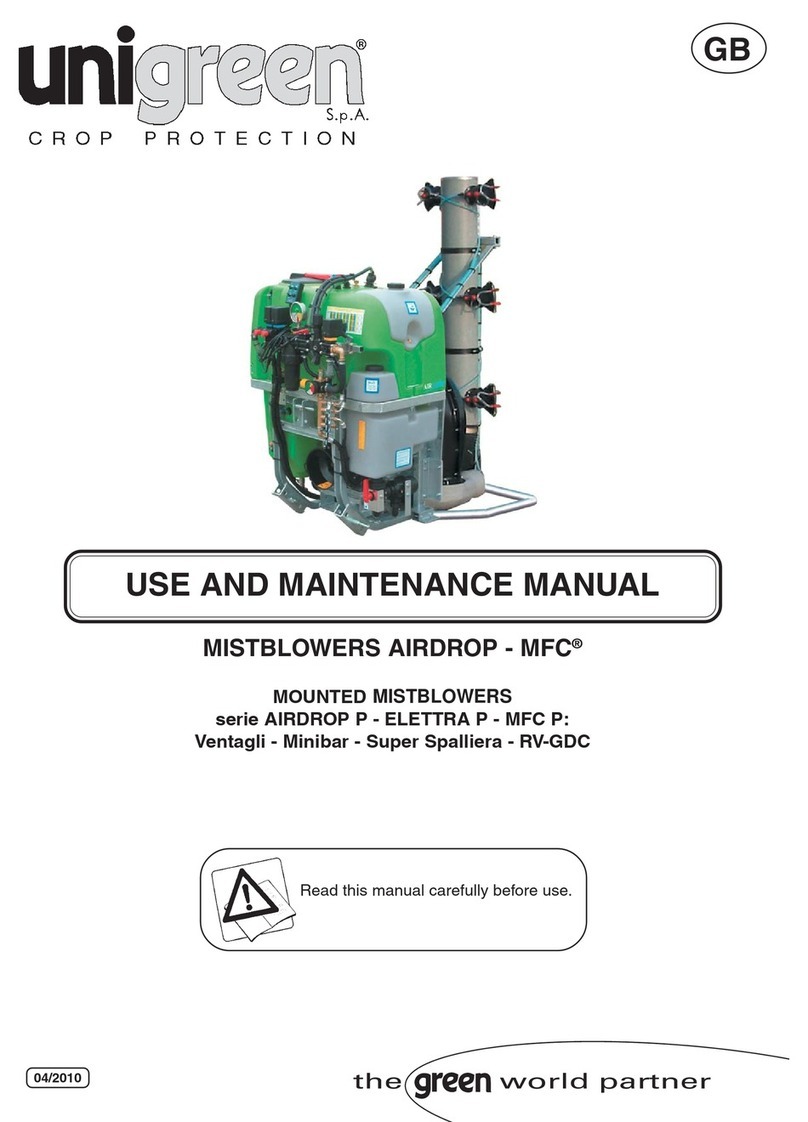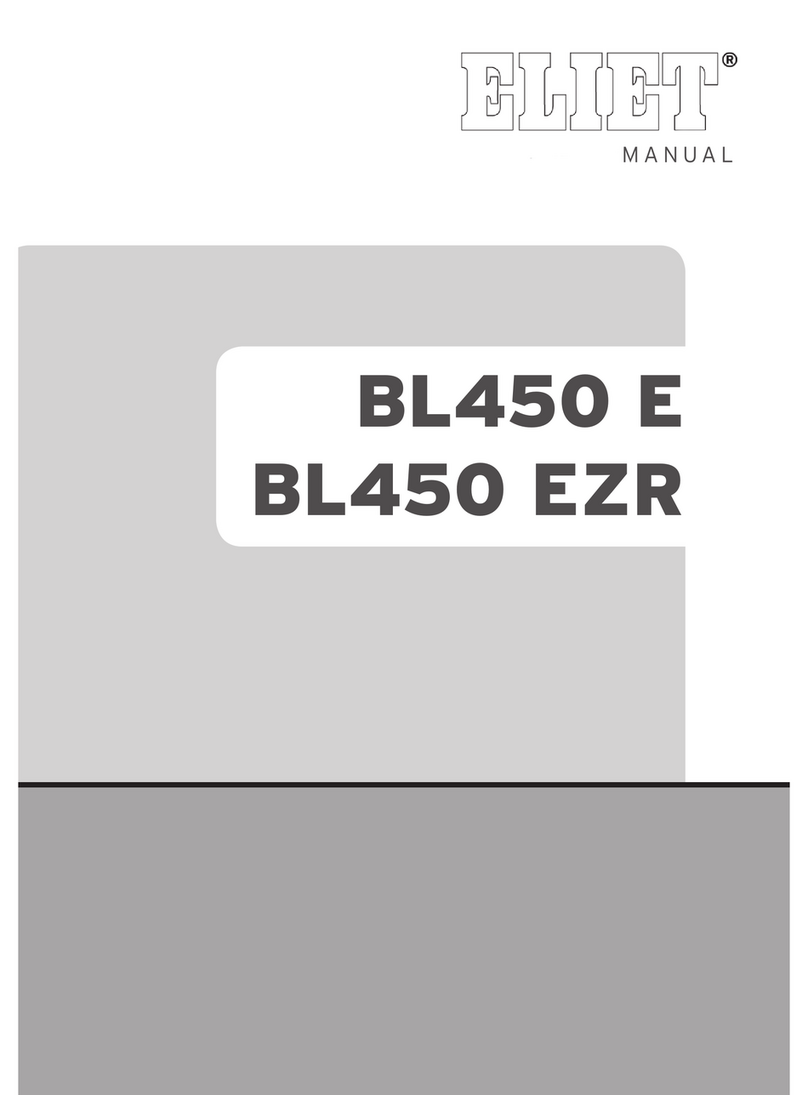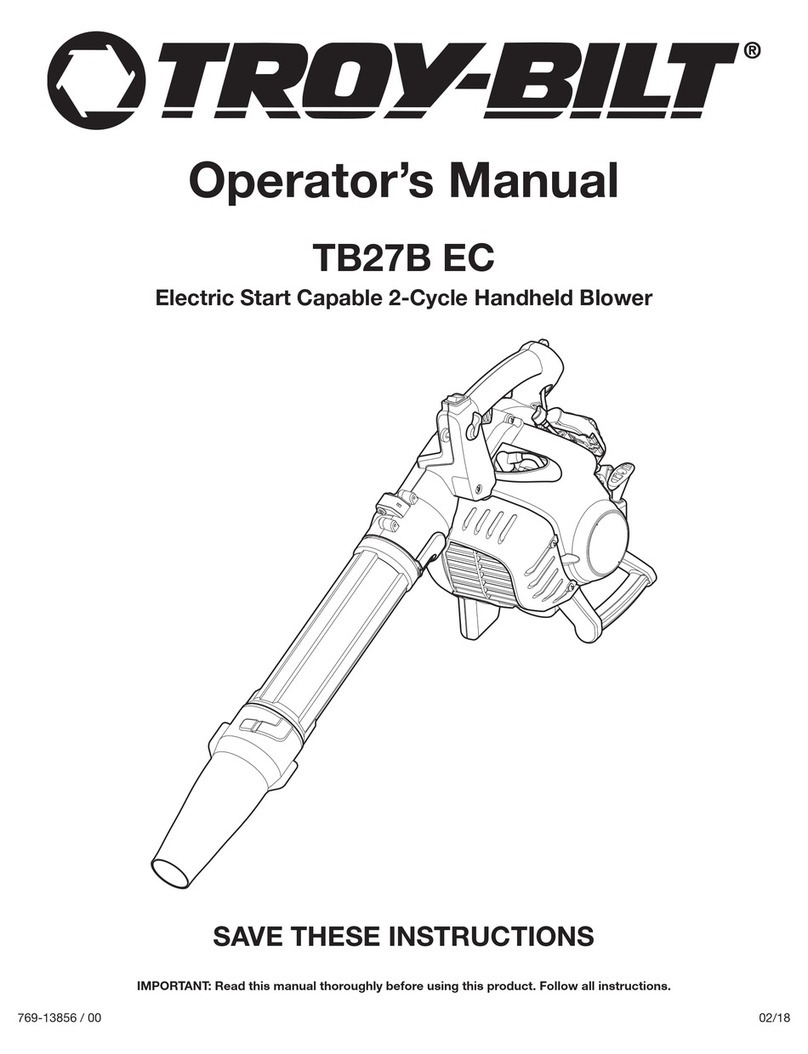Terramite TSS46 Guide

Copyright ©2006 Terramite Corporation
1.1
WWW.TERRAMITE.COM/SAFETY
1.800.428.3772
Intl. 1 .304.776.4231 Charleston, WV/USA
PARTS MANUAL
Read Operators Manual For Safety
Table of Contents
SECTION ONE: INTRODUCTION/INFORMATION
Table of Contents ........................................................................... 1.1
SECTION TWO: SAFETY GUIDELINES, MACHINE OPERATION AND
SERVICE
Safety Guidelines, Machine Operation
and Service .................................................................................. 2.1
Safety Guidelines ................................................................ 2.2 to 2.4
When Operating The Street Sweeper ........................................... 2.5
Hazards and Hazardous Areas ...................................................... 2.5
Transporting the Street Sweeper with a Trailer ......................... 2.6
Towing the Street Sweeper ................................................ 2.7 to 2.8
Storing the Street Sweeper ............................................................ 2.9
Engine Operating Instructions ......................................... 2.9 to 2.10
Weather Considerations ............................................................... 2.10
Periodic Service ............................................................................ 2.11
Engine Oil Service ........................................................................ 2.11
Hydraulic System Service ........................................................... 2.12
Street Sweeper Lubrication ......................................................... 2.13
Battery and Tires ......................................................................... 2.13
Paint and Cleaning ......................................................... 2.13 to 2.14
Trouble Shooting ............................................................ 2.14 to 2.15
Machine Operation Control Location .......................... 2.15 to 2.16
Lubrication and Maintenance Chart ............................. 2.16 to 2.17
Service and Maintenance Points ................................................. 2.17
Machine Trouble Shooting &
Hydraulic Component Check-Out ......................................... 2.17
Proper Care and Use of Broom Wafers ...................................... 2.18
Broom Core Removal/Wafer Replacement ................................ 2.19
Setting and Adjusting Broom ...................................................... 2.20
SECTION THREE: PARTS
Operator's Position & Wafers ....................................................... 3.1
View from Left Side of Operator's Position ................................ 3.2
View from Left Side of Operator’s Position ............................... 3.3
View of Front with Tow Bar ......................................................... 3.4
View of Tow Bar Extended ........................................................... 3.5
View of Right Front ....................................................................... 3.6
View of Steering ............................................................................. 3.7
View of Right Side Front ............................................................... 3.8
View of Left Side Front ................................................................. 3.9
View of Left Side Front ............................................................... 3.10
View of Right Side Brush Assembly .......................................... 3.11
View of Left Side Brush Assembly ............................................ 3.12
View of Lower Right .................................................................... 3.13
View of Lower Left ...................................................................... 3.14
View of Dash ................................................................................ 3.15
View of Under Dash .................................................................... 3.16
View of Behind Dash ................................................................... 3.17
View of Underside of Dash ......................................................... 3.18
View from Back of Operator's Seat Left Side ........................... 3.19
Rear View of Transmission/Pump Assembly ............................ 3.20
Left Side View of Transmission/Pump Assembly .................... 3.21
View of Under Seat Area ............................................................. 3.22
View of Lock Out & Left Side Assembly .................................. 3.23
Front Fork Assembly .................................................................. 3.24
Water System Routing ................................................................. 3.25
Sprayer Parts ................................................................................ 3.26
Brush Core .................................................................................... 3.27
Front Hub ..................................................................................... 3.28
Pivol Bearing Weldment Assembly ............................................ 3.29
Broom Mount Weldment ............................................................. 3.30
Brush Bar Assembly .................................................................... 3.31
Brush Bar Cylinder ...................................................................... 3.32
Brush Core Motor Mount .......................................................... 3.33
Brush Core Plate & Block For Motor Assembly ..................... 3.34
Spray Bar Assembly .................................................................... 3.35
Brake Hub Assembly ................................................................... 3.36
Brake Hub Assembly ................................................................... 3.37
Hoses Set Sweeper Parker Valves .............................................. 3.38
Hose Set Sweeper Saver Dantoss Valves ................................... 3.39
Hoses 6 ft. Sweeper ..................................................................... 3.40
Low Pressure Filter Assembly & High Pressure ...................... 3.41
Ground Drive Assembly ............................................................. 3.42
Gear Pump Part # 66000 Gas/66001 Diesel ............................. 3.43
Hydrastatic Transmission ........................................................... 3.44
Parts .............................................................................................. 3.45
110A Brush Motor Exploded View Parker ................................ 3.46
Kubota Engine .............................................................................. 3.47
Hydraulic Oil Change and Type Specifications ........................... 3.48
SECTION FOUR: HYDRAULICS
Hyraulic Schematic #1, Main Propel Drive V1 .......................... 4.1
Hyraulic Schematic #2, Steering/Auxiliary V1 ............................ 4.2
Hyraulic Schematic #3, Broom Drive V1 .................................... 4.3
Hyraulic Schematic, Wiring Harness for Kubota Engine ........... 4.4
Hyraulic Schematic, Wiring Elec. Gauge Panel ........................... 4.5
Hyraulic Schematic, Towbar Alarm .............................................. 4.6
Hyraulic Schematic, Isuzu Engine Harness ................................. 4.7
Hyraulic Schematic, Isuzu Wiring Harness ................................. 4.8
SECTION FIVE: DECALS
Right Side from Operators Position ............................................. 5.1
Right Side from Operators Position ............................................. 5.2
Left Side from Operators Position ............................................... 5.3
Right Side from Operators Position ............................................. 5.4
Dash ................................................................................................ 5.5
SECTION FIVE: TRANSLATIONS
Translations .......................................................................... 6.1 to 6.6
SECTION SIX: INDEX
Index ..................................................................................... 7.1 to 7.3
RECORDS
Serial Number _________________________
Model# ______________________________
Engine Type: __________________________
Engine Serial Number: __________________
Accessories: ___________________________
____________________________________
____________________________________
____________________________________
Courtesy of Machine.Market

Copyright ©2007 Terramite Corporation
2.1
WWW.TERRAMITE.COM/SAFETY
USA 1.800.428.3772
Intl. 1 .304.776.4231
PARTS MANUAL
Read Operators Manual For Safety
Service Operations
&
Charleston, WV/USA
1. Read all decals (See Decal Section) and manuals
before starting and/or operating the Terramite Street
Sweeper.
2. Do not make any adjustments or repairs or operate
if parking brake does not work, repair the parking
brake, first, before making any adjustments or other
repairs to this street sweeper.
3. Parking brake must be set before engine is started
and after it is stopped.
4. Protective eye wear must be worn while operating/
servicing/adjusting this machine or when working
within 100 feet of the Terramite Street Sweeper.
5. The Terramite Street Sweeper must not be operated
if any person is within working range of the sweeper
and/or is not wearing proper protective safety attire.
6. You must disengage both rear wheel lock outs before
making any repairs or adjustments.
7. Repairs and or adjustments must not be made with
the engine running. Otherwise, the operator must
be in his seat with parking brake set, wheel lock-
outs disengaged and wearing seat belt.
8. Do not start the Terramite Street Sweeper before
inspecting both transmission return to neutral springs.
Do not start if spring are not in place and functioning.
9. When servicing any electrical component, always
disconnect the negative battery cable first.
Safety Guidelines, Machine Operation and Service
10. Safety eye protection and attire must be worn when
servicing battery.
11. Never "Jump-Start" the Terramite Street Sweeper.
12. Industrial accepted safety practices must be followed
while operating/adjusting/repairing the Terramite
Street Sweeper.
13. Towing vehicle must meet or exceed all Federal/State/
Local laws for GVWR, lighting and hitch
requirements for all places machine will be operated.
14. Do not disconnect any hydraulic hose or fitting until
all hydraulic oil has cooled to ambient temperature
and machine is turned off. Then move valve handle
6 times in both directions to relieve residual pressure.
15. Do not change direction of the machine quickly.
Machine must come to a complete stop before
changing directions.
16. Do not tow this machine unless the front tire clears
the ground at least 6 inches, and the broom is properly
hooked up to an adequate tow vehicle.
17. Use only Federal, State or Locally recommended
Tow Bar Safety chains.
18. Machine must not be started/serviced or operated
unless you have read and fully understand the
manuals.
Courtesy of Machine.Market

Copyright ©2007 Terramite Corporation
2.2 WWW.TERRAMITE.COM/SAFETY
Charleston, WV/USA
USA 1.800.428.3772
Intl. 1 .304.776.4231
Read Operators Manual For Safety PARTS MANUAL
Service Operations
&
Important
In this section there are very important safety rules
that you must be aware of before operating any
Terramite product. When you see the symbol next
to a headline, it will indicate that the paragraph
contains important safety information.
For the Beginner
Regardless of whether you have purchased or rented a
Terramite Street Sweeper to perform a job that you wish
to complete as
quickly as pos-
sible, it is manda-
tory that you read
through the oper-
ating sections of
this manual before
operating the
machine. The few
minutes it will take
will not only give
you a solid basis for learning to operate the Terramite Street
Sweeper correctly, but you will have the assurance that
you are operating the machine in a safe manner. We have
made every effort to make the Terramite Street Sweeper
the safest machine of its kind in the industry, but that is as
far as we can go. The rest is up to you. Please help us by
carefully reading this handbook and complying with its
safety suggestions.
If You Must Use the Terramite
Street Sweeper Right Now
Without question it is to your advantage and safety that
you take the time to follow the operator training suggestions.
Only with some guidance can you expect to become a
master at the controls of a Terramite Street Sweeper in a
reasonably short period. However, if this is not possible,
first read the operating and safety rules section of the
handbook, then at least practice for about twenty minutes.
Just getting used to how the controls function will make
your first attempt at working with the machine far more
pleasurable, productive and, most important, safe.
Safety Guidelines
Suggested Training for the Beginner
We believe you will find the training procedures an
interesting and very rewarding experience. As you read
through the Operator’s Handbook, you will note that it is
as much a safety guide as it is an instruction manual.
Learning the various functions of the machine in a
programmed order is the most logical approach to becoming
a safe and skilled operator. It will take a little time but it
will undoubtedly be the best investment in time and money
you can make as a new Terramite Street Sweeper operator
and/or owner. Only when the operator has mastered the
controls of the machine and is in full command of its
capabilities will the owner fully realize the rewards of his
investment. Only after the operator has full knowledge of
the safety considerations of the Terramite Street Sweeper,
which are covered in this handbook, should he be allowed
to operator the machine.
Do I Need an Instructor?
At this point, it is only natural that there be some concern
as to whether or not you are taking on something that should
require an instructor. There is bound to be some question
in your mind as to whether you can possibly hurt the
machine or the machine can hurt you. The answer to both
questions is definitely YES, but not likely. As to the machine,
we have designed the Terramite Street Sweeper to protect
itself from exceeding its own limits. As to the operator,
we have made every effort to design and build the
Terramite Street Sweeper with your safety in mind. As to
the beginner, we have no record of anyone being seriously
injured while learning to use a Terramite Street Sweeper
and, to the best of our knowledge, the vast majority have
accomplished it pretty much on their own. However, we
feel the first step is to read the Operator’s Handbook. This
should give you some basis for determining whether you
may need personal instruction. If you feel you do, contact
your local dealer or call Terramite Corporation: 1-800-428-
3772.
We have your Safety in Mind.
Our experience would indicate that most beginners just
climb aboard and start pushing controls. Although it says
something about how easy it is to operate the Terramite
Street Sweeper, it completely ignores the safety aspects
of operating the machines. Even if you have someone
assisting you in learning to operate the Terramite Street
Courtesy of Machine.Market

Copyright ©2007 Terramite Corporation
2.3
WWW.TERRAMITE.COM/SAFETY
USA 1.800.428.3772
Intl. 1 .304.776.4231
PARTS MANUAL
Read Operators Manual For Safety
Service Operations
&
Charleston, WV/USA
Sweeper, you will have no way of knowing to what degree
they have prepared you as to the safety considerations of
the machine. READ THE HANDBOOK! It may not
cover every situation, but it covers those we believe to be
most important.
An Excellent Safety Record
In our constant reference to safety, we are well aware that
we are creating a false impression that the Terramite Street
Sweeper is a dangerous machine to operate. Regardless,
our continuous emphasis on safety is intentional, in the hope
of making you a safety minded operator. The Terramite
Street Sweeper has an excellent safety record, but as with
a powerful automobile in the wrong hands, it can be very
dangerous. Like the automobile, it is mostly a matter of
knowledge, attitude and respect for your own safety and
the safety of others that determines the degree of risk.
Driving the Terramite Street Sweeper
Note: Throughout this publication the word “drive” will
mean to operate the Terramite Street Sweeper from one
place to another. “Operate” will refer to all other functions.
Pre-Operation Inspection
Before starting the engine, check the fuel as well as the
engine and hydraulic oil levels, then made a walk-around
inspection to determine that everything appears normal.
The most important single thing you can do to increase the
life of the Terramite Street Sweeper is to properly lubricate
the pivot pins. When new, the pivot pins should be lubricated
every fours hours the first 20 hours, and every eight hours
thereafter. If you are going to haul the Terramite Street
Sweeper to a job, it is usually a good idea to perform the
pre-operation inspection before leaving for the job site.
This should include starting the engine and testing each
control of the Terramite Street Sweeper as well as driving
the Terramite Street Sweeper forward and backward. Do
not operate the Terramite Street Sweeper if you believe
that there might be a problem. Some minor problems can
become major problems if not attended to.
Hydraulic Pressure Considerations
As this may be your first experience with a machine that
functions primarily through hydraulic pressure, it is
imperative that you be aware of the danger of putting your
hands close to any part of the hydraulic components of the
machine while the engine is running or within two minutes
after being shut down. Be aware that escaping fluid under
pressure can be sufficient force to penetrate the skin,
causing serious personal injury. Fluid escaping from a very
small hole can be almost invisible. Therefore, we
recommend that you wear heavy work clothes that will
fully cover your body, leather work gloves and safety eye
protection when placing your hands around or near hydraulic
lines or fittings while under pressure. If you suspect a
leak, it can be quickly detected using a piece of cardboard
or wood. If injured by escaping fluid, go to the Emergency
Room of the nearest hospital. Be certain to inform them
that this type of injury can cause serious infection or a
reaction such as gangrene. If there is no hospital in the
area, call a physician immediately.
Being Mentally Prepared
Now, before attempting to operate the machine, read
through the following paragraphs involving driving the
Terramite Street Sweeper and be sure you have a good
mental picture of just what you are about to do and how
you will do it. Please note that our only goal in this first
session is for you to become familiar with the feel of driving
a Terramite Street Sweeper and using its' controls.
The Hydraulic Transmission
The Terramite Street Sweeper is a very simple machine to
operate but somewhat different than driving a car or truck.
This is because everything on a Terramite Street Sweeper
is driven by hydraulic pumps. The movements of the
broom head, the power steering and even the drive wheels
are the result of hydraulic pressure developed by these
pumps. The pump is driven by the diesel engine. The
drive wheels are powered by a hydrostatic transmission.
This transmission is a fluid drive device that provides
variable flow at a constant RPM from the engine to develop
the range of driving speeds used in performing the
Terramite Street Sweeper’s tasks. Only when you wish
to bring the Terramite Street Sweeper up to its maximum
road speed or maximum sweeping power will you need to
increase the engine RPM. For most work, all we do is set
the throttle at about 3/4 power, or a little less, and leave it.
The ground speed and direction of the Terramite Street
Sweeper is controlled by the hydrostatic transmission and
Forward/Neutral/Reverse valve.
Just a Little Does It
By lightly depressing the foot pedal we develop maximum
torque, which develops power like the low gear of a manual
Safety Guidelines (continued)
Courtesy of Machine.Market

Copyright ©2007 Terramite Corporation
2.4 WWW.TERRAMITE.COM/SAFETY
Charleston, WV/USA
USA 1.800.428.3772
Intl. 1 .304.776.4231
Read Operators Manual For Safety PARTS MANUAL
Service Operations
&
transmission in a truck. As we depress the foot pedal
further, the engine RPM remains about the same, but the
Terramite Street Sweeper picks up speed over the ground.
The big difference between driving the Terramite Street
Sweeper and a truck is that if you want power to start up
a hill, you need only depress the foot pedal about a third of
the way forward, not to the floor. If you want speed, you
start off with a small amount of pedal and keep increasing
as the speed builds up and the required torque decreases.
No Gear Shift
When the drive pedal is in neutral position, it’s like applying
a brake. Anytime the engine tends to slow, let up on the
pedal a little. You have to experience it to appreciate it.
Although somewhat different in its control, the hydrostatic
transmission is very easy to use and very forgiving. It
takes only minutes to get used to, and is simpler to use
than an automatic transmission in an automobile.
Some “Don’ts”
Excessive RPM can damage the engine and make the
controls overly responsive. Do not change the relief valve
settings. They are factory set for best machine
performance. Do not go from forward to reverse or reverse
to forward without pausing at neutral. It may damage the
drive train.
Getting Started
Now we are ready to get aboard. Make certain that there
is no oil on the steps, which might cause you to slip and
fall. Your seat may be adjusted to different positions by
pulling the lever located under the seat on the right. Before
starting the engine, be sure to fasten your seat belt.
Terramite Corporation believes that a seat belt should be
worn at all times.
Some Never, Never, Nevers
Never use the Terramite Street Sweeper for a job it wasn’t
intended to do. Never use any other part of the machine
as work platform or a personnel carrier. Never allow
anyone to be under, or even close to the broom or any part
of the sweeper. Never touch the hydraulic components
when, or right after, the machine has been working. They
reach temperatures in excess of 200 degrees and can give
you a severe burn.
Slow Down, Speed Kills
Be particularly alert when backing or working in crowded
areas. Always operate the Terramite Street Sweeper at a
safe speed, keeping in mind your safety and that of any
other people working in the area.
Not Too Much at One Time
As a beginner, this practice will require your total
concentration. Therefore, while learning to use the street
sweeper, we recommend that you do not put in over half
an hour of practice without a half-hour break. Confusion
and panic can be brought on from mental exhaustion, which
can occur very rapidly until the use of the controls becomes
a somewhat automatic reaction. Long sessions, requiring
extreme concentration, can be potentially dangerous.
Working on a Slope (Use Extreme
Caution)
Now we will cover one of the most important considerations
in operating the Terramite Street Sweeper. Naturally, you
will be working on some degree of ground slope much of
the time unless you live in very flat country. We feel it is
extremely important that we impress upon you just how
treacherous a slope can be when using this machine,
particularly under certain conditions. If you operate on a
hillside that is slippery and/or steep enough that there is
any question that the Terramite Street Sweeper will not be
able to maintain braking action, you will be taking your life
in your own hands. Unless you are absolutely sure that
you can accomplish the work without risk, do not attempt
it. A slick surface, such as dry leaves on even a slight
grade, may cause your rear tires to slide out of control
without any braking action whatsoever.
Emergency Procedures
Before working a hazardous area such as a hillside, take
time to consider every possible problem you might
encounter. Be sure you are mentally prepared for any
situation and know exactly what you might do in an
emergency. Remember, panic is your worst enemy, and
panic usually comes when you are caught completely off
guard and unprepared. Safety conscious operators run
through emergency procedures before operating under any
conditions that give them concern.
Safety Guidelines (continued)
Courtesy of Machine.Market

Copyright ©2007 Terramite Corporation
2.5
WWW.TERRAMITE.COM/SAFETY
USA 1.800.428.3772
Intl. 1 .304.776.4231
PARTS MANUAL
Read Operators Manual For Safety
Service Operations
&
Charleston, WV/USA
When Operating the Street Sweeper
First Aid and Fire. Keep a fire extinguisher and a first aid
kit nearby and know how to use them.
Loose Clothing. Never take chances by wearing loose
clothing, watches or rings. Keep clothing and hands away
from moving parts.
Only Room for One. When in operation, only the operator
should be permitted on the machine.
Mounting the Machine. Always mount your machine
from the side. Put one foot on the machine at a time. Never
mount from the rear or while the engine is running. Before
you start the engine, always fasten the seat belt. When in
operation, do not jump either on or off the machine. Never
mount or dismount a moving machine.
Starting the Terramite Street Sweeper. Do not attempt
to start or operate the Terramite Street Sweeper except
from the operator’s station. Never operate the controls from
the ground, as this could result in serious injury or even death.
Prevent Accidental Starting. Disconnect the negative
wire from the battery. Put a Lock Out Tag on the machine
while being serviced. Remove key.
Other Battery Considerations. Do not use the battery
charger as a booster to start the engine. Never disconnect
Hazards and Hazardous Areas
Approved Container. Always use an approved container
when handling and storing diesel fuel or solvents.
When Loading Fuel. Never fill the fuel tank while
smoking, when near an open flame or with the engine
running. Leave room for fuel expansion, 1-1/2 to 2 inches.
Replace fuel cap securely.
Cleaning Parts. Never use gasoline or diesel fuel for
cleaning parts. Always use a nonflammable solvent.
Overhead Wires. Watch for overhead wires and cables.
Never touch the wires with any part of the machine. If
you contact an electric line, stay on your machine until
help arrives, if you are not being shocked. If you have to
jump from the machine, make sure you are not touching
the machine as you hit the ground.
Two Men, if Possible. When working in hazardous areas,
be extremely alert. If possible, two men should work
together, one operating the machine and the other directing
him and watching for dangers. Develop a hand signal
system or use hand signals shown on page 1.4.
Unventilated Area. Never operate the Terramite Street
Sweeper in an unventilated area. Carbon monoxide and
methane gas are colorless and odorless.
Explosion. Sparks can come out of the muffler or the
electrical system. Do not operate the machine in areas
where there are flammable vapors or dusts that are of the
nature that would cause an explosion.
the battery when the engine is running. Never attempt to
charge a frozen battery. An explosion may occur.
Operating at Excessive Speed. Operating unit at
excessive speeds increases the danger of personal injury.
Do not change the governor setting or tamper with
components which may increase speed.
Excessive Hydraulic Pressure. Do not raise the hydraulic
pressure beyond 2200 PSI. Components may become
overloaded and break, causing serious injury. This also
shortens the life of your machine.
Excessive Tire Pressure. Never exceed maximum
recommended tire pressure, as serious injury or even death
may result.
Relief Valve Settings. Do not change the relief valve
settings. They are factory set for the best machine
performance and safety. If it becomes necessary to adjust
this setting, refer to the Terramite Street Sweeper Service
Manual for the proper procedure.
Parking Machine. Always park your machine on level
ground with parking brake engaged.
Prevent Fire. Be cautious of fire when operating in dry,
dead grass or brush.
Courtesy of Machine.Market

Copyright ©2007 Terramite Corporation
2.6 WWW.TERRAMITE.COM/SAFETY
Charleston, WV/USA
USA 1.800.428.3772
Intl. 1 .304.776.4231
Read Operators Manual For Safety PARTS MANUAL
Service Operations
&
Transporting the Street Sweeper with a Trailer
General Considerations
Proper Towing Equipment. It is important that you use
a truck that is capable of towing the trailer and the Terramite
Street Sweeper, and that it is equipped with the proper tie-
down equipment for securing it to the trailer. When on a
road or highway, at night or during the day, use accessory
lights and an SMV (Slow Moving Vehicle) sign for adequate
warning to other drivers. In this regard, check state and
local regulations.
Do Not Wrap Chains Around Cylinder Rods.
This may scar or bend them.
MAXIMUM TOWING SPEED WITH A
TRAILER IS 60 MPH
Trailer Size and Type
The trailer you select should have a load carrying capacity
of at least 7000 pounds with a tandem axle, and at least 14
feet long. You will need to check with State authorities as
to whether electric or hydraulic surge brakes are permitted.
Loading Can Be Tricky
After setting the truck’s emergency brake and blocking
the wheels of the truck and the trailer, drive the machine
slowly onto the trailer. Keep in mind that the weight of the
Terramite Street Sweeper going onto the trailer may raise
the rear of the truck off the ground, causing the truck,
trailer and Terramite Street Sweeper to roll forward.
Driving onto a tilt bed trailer can also be very tricky as the
trailer bed will likely slam down, tending to make you
overcompensate by going backwards, thus causing the
trailer to seesaw back and forth.
Securing the Terramite Street
Sweeper to a Trailer
Once the Terramite Street Sweeper is positioned on the trailer,
block each side of the front and rear tires. Using chains, bind
it to the trailer. There are binding rings welded onto the frame
under the engine and on the front. Always put the binders
toward the front and the rear, never straight out. The machine
may shift if the binders are placed at 90 degree angles.
Measure the height of the machine on the trailer so you will
know the minimum height under which you can pass.
CAUTION!
Always place the load binder handles on the right so you
can tighten them down without exposing yourself to oncoming
traffic. It is good practice to use a piece of tie wire to keep
the handle from flying up. Be careful if you use a cheater
bar to lock binders down. Fingers have been broken when
the binder flings over center. A ratchet binder is the best,
followed by over center binders. Come alongs are not very
safe due to their poor construction. Make sure all loose
items are secured. Be sure to check tightness after you
start, and periodically as you travel, as the load may shift.
Towing Considerations for the
Terramite Street Sweeper
At highway speeds, if there is too much weight on the
back of the trailer, it may suddenly and without notice start
whipping violently back and forth. This can be very
dangerous and is caused by not having enough weight on
the tongue. It can be corrected by properly positioning the
Terramite Street Sweeper on the trailer. Too far forward
may produce more weight than the hitch or even the truck
can handle; whereas, too far back can be dangerous, as
described above. It is a good idea to go to a weigh station,
and after determining the best position, mark where to park
the wheels. You must also be careful as to just where you
place any additional cargo you may take along. Most trailer
manufacturers recommend that 10% of the weight be on
the tongue.
CAUTION!
Test the braking capabilities of the truck and trailer
combination on the first clear stretch of road. Most brake
controllers can engage the trailer brakes independently of
the towing vehicle’s brakes. This feature can be used to
help straighten out a skid.
Safe Towing Practices
SAFETY FIRST! Always maintain extra distance from
the vehicles in front of you and allow extra room when
turning corners. Make lane changes slowly to keep the
load from shifting, and let other drivers, who may be in
your blind spot, get out of your way. Periodically check
your trailer and safety equipment. Remember, you are
towing the equivalent of a small pickup truck behind you.
Courtesy of Machine.Market

Copyright ©2007 Terramite Corporation
2.7
WWW.TERRAMITE.COM/SAFETY
USA 1.800.428.3772
Intl. 1 .304.776.4231
PARTS MANUAL
Read Operators Manual For Safety
Service Operations
&
Charleston, WV/USA
4. Remove the tow bar lower locking pin (See Figure 4).
5. Start sweeper engine. Helper uses tow bar lift valve
(See Figure 5) to raise tow bar to towing truck height.
6. Connect tow bar to towing truck and secure.
7. Use tow bar lift valve to raise front of sweeper until
the tow bar lower locking pin can be replaced and
secured.
8. Attach safety chains and light cord to towing truck.
9. Place broom assembly in up position and secure with
its chain.
10. Turn off engine, release parking brake, and disconnect
lock out hubs (See Figures 6 & 7).
11. Drain water tanks (See Figure 8).
12. To prepare broom for service after towing, reverse
order of these instructions.
CAUTION!
Test the braking capabilities of the truck with sweeper prior
to driving on the road.
Safe Towing Practices
SAFETY FIRST! Always maintain extra distance from
the vehicles in front of you and allow extra room when
turning corners. Make lane changes slowly, and let other
drivers, who may be in your blind spot, get out of your
way. Periodically check your sweeper and safety
equipment. Remember, you are towing the equivalent of a
small pickup truck behind you.
Towing the Street Sweeper
General Considerations
Proper Towing Equipment. It is important that you use
a truck that is capable of towing the sweeper. When on a
road or highway, at night or during the day, use accessory
lights and an SMV (Slow Moving Vehicle) sign for adequate
warning to other drivers. In this regard, check state and
local regulations.
Do Not Wrap Chains Around Cylinder Rods.
This may scar or bend them.
MAXIMUM TOWING SPEED IS 60 MPH
Attaching Sweeper To Towing Truck
1. Park truck on level ground, turn off engine, and set
parking brake.
2. Drive sweeper near truck. Turn off sweeper engine,
set sweeper parking brake (See Figures 1 & 2).
3. Remove tow bar upper locking pin (See Figure 3)
and place tow bar in line with sweeper (See Figure
4). Re-attach tow bar upper locking pin, making
sure its secure
WARNING!
To prevent injury have someone assist in the removal of
the tow bar upper locking pin and lowering of the tow bar.
Courtesy of Machine.Market

Copyright ©2007 Terramite Corporation
2.8 WWW.TERRAMITE.COM/SAFETY
Charleston, WV/USA
USA 1.800.428.3772
Intl. 1 .304.776.4231
Read Operators Manual For Safety PARTS MANUAL
Service Operations
&
FIGURE 5
WATER TANK
DRAIN
FIGURE 3
LOCK OUT HUB
ENGAGED
FIGURE 4
LOCK OUT HUB
DISENGAGED
FIGURE 2
PARKING BRAKE
ENGAGED
FIGURE 1
PARKING BRAKE
DISENGAGED
Courtesy of Machine.Market

Copyright ©2007 Terramite Corporation
2.9
WWW.TERRAMITE.COM/SAFETY
USA 1.800.428.3772
Intl. 1 .304.776.4231
PARTS MANUAL
Read Operators Manual For Safety
Service Operations
&
Charleston, WV/USA
WARNING!
Do not activitate the starter for more than 20 seconds. If
the engine does not catch, wait one minute then try again.
WARNING!
If engine does not start after 2 attempts, refer to operation
manual supplied with the machine or call Terramite Service
Technicians for assistance.
Starting Kubota and Deutz Engines
1. Place key in ignition
2. Turn key clock wise to start position.
4. Release Key as soon as engine fires.
WARNING!
Do not activitate the starter for more than 20 seconds. If
the engine does not catch wait one minute then try again.
WARNING!
If engine does not start after 2 attempts, refer to operation
manual supplied with the machine or call Terramite Service
Technicians for assistance
NOTE: With your Terramite Street Sweeper you will
receive an Operation and Service Folder for the particular
engine supplied with your machine. This manual contains
detailed information as to operation, maintenance and repair
of the engine and its various components. However, before
attempting any major repair of the engine, contact your
dealer or the factory as to whether it will affect your factory
warranty.
Before starting make sure that nobody is standing
in the immediate vicinity of the engine or driven machine.
1. ENGAGE PARKING BRAKE
2. CHECK THAT MACHINE IS IN NEUTRAL
3. CHECK THAT BROOM ROTATION IS IN OFF
POSITION
Engine Fuel
WARNING! Diesel fuel, although less explosive than
gasoline, is highly flammable, and its vapors can explode
under certain conditions. Store diesel fuel only in approved
containers in unoccupied buildings and away from sparks
or flames. Do not add diesel fuel while the engine is hot or
running, or start the engine near spilled fuel.
Storing the Street Sweeper
For Storage of More than 30 Days
To insure maximum performance and minimum
deterioration, the following procedures should be performed
when the Terramite Street Sweeper will be idle for more
than 30 days:
1. Wash the Terramite Street Sweeper and let dry
(waxing will help prevent paint oxidation).
2. Change engine oil.
3. Charge battery fully and disconnect the battery leads.
4. Fill fuel tank within 2 inches of filler neck (keeps out
condensation) and add fuel conditioner.
5. Squirt a small amount of oil into cylinders and crank
the engine over a few times.
6. Grease all pivot pins. Liberally apply cup grease to
all bare metal surfaces such as buckets and exposed
cylinder rods. Grease all pivot pins. Retract all
cylinder rods. Use WD40 on all electrical parts and
areas inaccessible to regular grease.
7. Set the Terramite Street Sweeper on stands so the
tires are off the ground. (Keeps tires from developing
flat spots.)
8. Deflate tires to 1/2 pressure to relax cords.
9. Use a protective such as Armor All®on hoses, seat
and tires to keep them from weathering
10. If the Terramite Street Sweeper is to be stored
outside, cover with a tarp or plastic cover to minimize
weathering.
Engine Operating Instructions
Courtesy of Machine.Market

Copyright ©2007 Terramite Corporation
2.10 WWW.TERRAMITE.COM/SAFETY
Charleston, WV/USA
USA 1.800.428.3772
Intl. 1 .304.776.4231
Read Operators Manual For Safety PARTS MANUAL
Service Operations
&
Do Not Use Ether as a Starting Aid
The engine has a high compression ratio, and using ether
will ruin your engine. The damage will not be covered
under your warranty.
Total Failure of Starter
If the starter does not turn the engine over, shut off the
starter immediately. Do not make further attempts to start
the engine until the condition is corrected.
CAUTION!
Do not crank the engine continuously for more than 20
seconds at a time. If the engine does not start, allow a two
minute cool-down period between starting attempts. Failure
to follow these guidelines will burn out the starter motor.
CAUTION!
If the engine develops sufficient speed to disengage the
starter but does not keep running (a “false start”), the engine
rotation must be allowed to come to a complete stop before
attempting to restart the engine, or engine damage may
result.
WARNING!
Do not tamper with the governor setting to increase the
maximum engine speed. Over-speeding is hazardous and
will void the warranty.
WARNING! Do not use JP4 Fuel or Ether
The minimum centane number 45 (Aviation fuel) JP4 or
either starting fluids must not be used.
Weather Considerations
Diesel Operation in Hot Weather
Operating the diesel engine in hot weather is mostly a
matter of keeping the coolant at the correct level, the
radiator clean and keeping an eye on the fan belt. Also, be
certain of the viscosity of lubricants.
Temperatures Below 32 Degrees
There are several precautions which must be followed
when the temperature drops below 32 degrees Fahrenheit.
The oil in the engine and the hydraulic system needs to be
changed to winter weight and a new oil and air filter should
be considered. The battery should be kept at full charge.
As starting may be more difficult, be sure that you do not
run starter more than 20 seconds, followed by a two minute
cooling off period. Do not hit the outside of the casing of
the starter, as you may break the ceramic magnets.
Fuel Conditioner For Diesel Engines
Diesel fuel gets waxy at low temperatures and may not
flow through the filter and pump at the normal rate of flow.
Therefore, a good fuel conditioner additive is highly
recommended for temperatures below 32 degrees
Fahrenheit.
Below 10 Degrees
Special procedures must be followed so your machine may
be readily started without damage. The hydraulic system
and the engine need to be fitted with electric heaters. The
machine can be warmed with a high output forced air
heater.
Engine Operating Instructions (continued)
Courtesy of Machine.Market

Copyright ©2007 Terramite Corporation
2.11
WWW.TERRAMITE.COM/SAFETY
USA 1.800.428.3772
Intl. 1 .304.776.4231
PARTS MANUAL
Read Operators Manual For Safety
Service Operations
&
Charleston, WV/USA
Engine Oil Service
Engine Oil (Recommended)
Refer to engine operating manual supplied with machine.
Checking Engine Oil
Before checking the oil, make sure the engine is stopped
and resting on a level surface. Also, make sure the engine
is cool and the oil has had time to drain into the sump.
Bring the level up to, but not over, the full mark on the dip
stick. Always check the level before adding more oil.
CAUTION:Do not operate the engine above or below
marked area on the dip stick.
Changing Engine Oil
For a new engine, change oil after the first 5 hours of
operation, after that every 100 hours (50 if multi-viscosity
oil is used). Drain oil while the engine is warm from
operation. The oil will flow freely and carry away more
impurities. Drain oil as follows: Remove the oil drain plug
and oil fill cap. Dispose of the oil in a manner that meets
Local, State and Federal regulations. Reinstall the drain
plug. Make sure it is tightened securely. Be sure the
engine is level when filling and checking oil. Then fill with
new oil to the top line on the dipstick. Refer to engine
operating manual for proper type. Always check the level
on the dipstick before adding more oil. Reinstalled the oil
fill cap and make sure it is tightened securely.
Changing the Engine Oil Filter
Your Diesel is equipped with an oil filter. Replace the oil
filter, in accordance with the “Oil Change Intervals” table.
Always use a genuine OEM oil filter and replace as follows:
Drain crankcase oil, then remove old filter. Before installing
replacement filter, apply a thin coating of clean oil on the
surface of the rubber seal. Turn filter clockwise until rubber
seal contacts the filter adapter, then tighten filter an
additional 2/3 to 3/4 turn. Add an additional 1/2 pint of oil
for the filter capacity. Start the engine and check for oil
leakage.
Extended Engine Oil Change Intervals
NOTICE: Using other than the proper class oil or
extending oil change intervals longer than recommended
will cause engine damage which is not covered by the
engine warranty.
Engine Air Filter (Paper Element)
The diesel engines are equipped with a high-density paper
air cleaner element. The paper element should be replaced
every 100 hours. Do not wash or use pressurized air to
clean the paper element. Before installing new filter, be
sure to inspect it for damage and that it fits perfectly when
replaced.
General Considerations
These required maintenance procedures should be
performed at the frequency stated in the table. They should
also be included as part of any seasonal tune-up. Perform
these maintenance procedures more frequently when the
engine is operated under extremely dusty or dirty conditions.
Although your Terramite Street Sweeper is made of the
finest and most durable materials, it will only hold up if
given proper care. The maintenance procedures are very
simple and easy to do. We have also included space in the
back of this handbook for keeping a service record of your
machine.
IMPORTANT: See attached New Machine First
Service Schedule for items that should be checked or
serviced during the first 4 to 50 hours.
Periodic Service
REQUIRED MAINTENANCE FREQUENCY
Clean Air Intake Screen Daily
Check Engine Oil Level Daily
Check Hydraulic Oil Level Daily
Check/Replace Fuel Filter** As Required
Change Oil and Filter As Specified
Clean Cooling Fins and
External Surfaces 50 hrs. or as required
**SEE ENGINE MAINTENANCE MANUAL
We also suggest that the air filter be checked weekly
in the event you are working in extremely dirty or dusty
conditions. The manufacturer’s air filter should be
used, or warranty may be denied. Otherwise, check
and clean monthly.
Courtesy of Machine.Market

Copyright ©2007 Terramite Corporation
2.12 WWW.TERRAMITE.COM/SAFETY
Charleston, WV/USA
USA 1.800.428.3772
Intl. 1 .304.776.4231
Read Operators Manual For Safety PARTS MANUAL
Service Operations
&
Hydraulic System Service
Check Hydraulic Oil Level Daily
Before checking the hydraulic oil sight gauge, all cylinders
should be retracted. The correct oil level is halfway up
the sight gauge. To avoid damage to the hydraulic pumps,
drain and replace milky-looking oil. Proceed as follows to
drain the oil out of the reservoir tank.
Hydraulic Oil Filter
When the machine is new, the system oil and filter should
be changed within the first 50 hours. After that, every 200
hours. Fill system with API SF/CD 10W below 40 degrees.
Oil should be changed on a level surface. It is
recommended that the oil be changed right after use while
the oil is warm.
Hydraulic Oil Leaks Can Be Dangerous
WARNING! As this may be your first experience with a
machine that functions primarily through hydraulic
pressure, never inspect or put your hands close to any part
of the hydraulic components of the machine while the
engine is running or within two minutes after being shut
down. If injured by escaping fluid, go to the emergency
room of the nearest hospital at once and tell them the nature
of the injury. If there is not a hospital in the vicinity, call a
physician. Serious infection or a reaction such as gangrene
can develop if proper medical treatment is not administered
immediately.
Minor Hydraulic Oil Leaks
Oil leaks are often difficult to locate, as oil may leak from
areas in the machine that are hidden from view. However,
if you can locate the leak, take a cloth and completely dry
everything around the leak to determine how fast the oil is
escaping. A drop of oil every 10 seconds is only 1/2 oz.
per hour. Do not use teflon tape to try to stop a leak, as it
can get loose in the system. You can easily over tighten a
fitting or hose wrapped with teflon, causing a housing to
crack. The preferred sealant is Loktite™ hydraulic thread
sealant with teflon paste.
DANGER! Oil and Fittings Get Hot
It is normal for the hydraulic oil to reach 170 degrees; and
the hydraulic hoses, cylinders and components, acting as a
large passive radiator, can reach temperatures of over 200
degrees. However, if the surface or hydraulic oil
temperatures exceed these temperatures, it may be caused
by having a control valve held open too long. Always return
control valve to neutral when not in use. It could also
indicate a low oil supply or contaminated oil. If low, refill.
If contaminated, drain and refill with new oil, and replace
filter. It could also indicate a kink or dent in a hose line or
a worn pump. (See Service Manual for Pump
replacement.)
NOTE: Always make sure major leaks are contained
and the oil disposed of in a proper manner. Stains on
concrete may be removed by applying a mixture of oil dry
and solvent. Let mixture set for a few hours before
removal. Dispose of according to applicable Local/State/
Federal Laws.
Changing the Hydraulic System Oil
1. Make sure all the cylinder rods are fully retracted.
2. Remove the sump line.
3. Remove the sump strainer, wash it in solvent, dry
thoroughly.
4. Replace in reverse order.
5. Fill the system with recommended oil until it reaches
the proper level.
NOTE: There is no need to bleed the hydraulic system,
the air will come out of the oil by itself. The machine may
vibrate for a few minutes until the air purges. Be sure to
dispose of your waste oil in a manner acceptable to Federal,
State and local authorities.
Some Tips on Hydraulic Hoses
Inspect hoses regularly for nicks, cuts and wear. There
are two wire braid layers under the rubber outer cover.
When wire is exposed but undamaged, the hose still may
be used, but should be replaced as soon as possible.
If You Need New Hydraulic Hoses or Parts
All hoses are JIC. Hoses may be obtained from Terramite
Corporation or any industrial rubber supplier or hydraulic
shop. Return the old hoses so they can match them. Short
hoses may be made from the good portion of a damaged
hose.
Courtesy of Machine.Market

Copyright ©2007 Terramite Corporation
2.13
WWW.TERRAMITE.COM/SAFETY
USA 1.800.428.3772
Intl. 1 .304.776.4231
PARTS MANUAL
Read Operators Manual For Safety
Service Operations
&
Charleston, WV/USA
Lubricating the Pivot Pins
The most important single thing you can do to increase the
life of the Terramite Street Sweeper is proper lubrication
of the pivot pins. The pivot pins should be lubricated with
a good lithium based grease every four hours of operation.
Wipe dirt from the fittings before greasing. Replace any
lost or damaged fittings immediately.
How to Ruin a Good Machine
The first 20 hours of use are critical to the life of the
machine. The pivot pins have minute edges which need
to be broken in just as an automobile engines need to be
broken in. If the pins are not adequately greased, they will
break their retainers and work out, possibly causing damage
to your machine. An ungreased pin will rust. The next
time you use the machine the rust wears off, exposing
more metal, which also rusts. The rust and dirt make a
destructive grinding compound. Many people falsely blame
the manufacturer for their own neglect in lubricating the
machine. This is not covered under your warranty.
Use Caution when Replacing Pins
When driving pivot pins in or out, use care to guard against
injury from particles that may chip off the pin or object
used in striking the pin. These pins can fly out at
considerable speed if they are not tapped lightly just before
they come out. Safety glassed must be worn.
Battery and Tires
Low Maintenance Battery
Your Terramite Street Sweeper is equipped with a low
maintenance battery. It uses a special construction to
minimize water requirements. There is an “eye” on the
battery to determine the conditions.
Cold Weather Considerations
NOTE: Cold weather makes a marginal battery useless.
A battery fully charged at 80 deg. F. will have only 60% of
its capacity at 32 deg. F., and only 40% at zero. A half-
charged battery has only 32% at 32 deg. F and 21% at
zero.
Tire Pressures and Rim Size
Titan - ST Radial 205/75R14
50PSI Cold -Load 1760 Lbs.
Avoid High Tire Pressure
CAUTION! Excessive tire pressures increase the
possibility of punctures and cause a rougher ride. The rim
or tire could blow out, causing extreme injury or even death!
Tire Traction and Hazards
Avoid excessive wheel spin when loading. On most
surfaces, wheel spin causes loss of traction and premature
wear out of tires. Watch for hazards such as nails, glass,
etc.
Paint and Cleaning
Protecting the Paint
Because it is highly resistant to nearly everything, it requires
little care. But constant exposure to sunlight will fade it
just as other paints eventually fade. A coat of wax will
help protect it. Leaving spilled diesel on your hood is not
only an unsafe practice, but will cause stains and will
inevitably eat through your paint. Small scratches should
be touched up or kept waxed to keep rust from attaching
the metal under the paint.
Street Sweeper Lubrication
Courtesy of Machine.Market

Copyright ©2007 Terramite Corporation
2.14 WWW.TERRAMITE.COM/SAFETY
Charleston, WV/USA
USA 1.800.428.3772
Intl. 1 .304.776.4231
Read Operators Manual For Safety PARTS MANUAL
Service Operations
&
Paint Cleaning Solutions
Some cleaning solutions and solvents used in high pressure
washers may bleach the finish if used in high concentration
or not rinsed from the machine. This can be avoided by
diluting the cleaning solution or not letting it set too long.
Fasteners (Nuts and Bolts)
It is particularly important to check all nuts and bolts for
tightness after the first 5 hours of use. All drive train bolts
should receive extra attention. Thereafter, check every
250 hours.
If a particular difficulty is experienced, check the symptoms
listed below. Possible causes and remedies are given for
each symptom. If the trouble is not corrected after
following the suggested solution, call your dealer or call
Terramite Corporation.
Total Failure of Hydraulic Power
(Engine is running, but nothing works)
Stripped engine to transmission coupling. Must be replaced.
Loss of Tram Power
The hubs may be disengaged for towing. This will cause
loss of tram power.
This may indicate a worn transmission. Check with factory
technician
Loss of Sweeping Power
Check for:
1. Low hydraulic oil.
2. Collapsed hose (hose can collapse internally, not
showing any visible signs.)
3. Worn Pump. Check pump pressure.
4. Internal Valve leakage. Valves will sometimes
develope leaks between the spools, yet not leak
outside. Switching hoses to another valve will
determine whether the valve section is bad.
5. Broken or weak relief valve. Check pressure. Check
for fatigued or broken relief valve spring. All
cylinders will lack power. You will have a little more
power when your machine is cold. A weakened
spring will lose power so gradually that you may not
notice the decline in power until it seriously affects
the machine performance. A broken spring will cause
a sudden drop in cylinder power.
Trouble Shooting
Sluggish and Slow Operation
Oil still cold. Pump badly worn or damaged. Restriction
in suction line. Clogged oil filter or sump strainer.
Control Valve Sticks or Works Hard
Normally, this is a problem for your dealer's service
department. It is usually dirty valves, tie bolts too tight or
float detent position adjusted too tight.
Street Sweeper Doesn't Move in Either
Direction
If this happened over a period of time, the transmission is
totally worn out. If it happened instantly, check for the
following:
1. Make sure rear lock-outs are in.
2. Foot pedal disconnected.
3. Bolts broken on coupling.
Transmission/Pump Makes Noise
First check the oil viscosity. If too high, replace with
specified oil. Then look for a kink or dent in oil lines. If
not of these, it may be air in the system. See your dealer.
Erratic Motion
1. Retract all rods and check hydraulic oil level.
2. Broken or weak pedal spring.
3. Worn transmission.
Hydraulic Oil Foams
1. Low oil supply.
2. Air leak in line from reservoir to pump.
3. Incorrect hydraulic oil.
4. Blocked valve restrictor.
5. Check sump hose for tightness.
Paint and Cleaning (continued)
Courtesy of Machine.Market

Copyright ©2007 Terramite Corporation
2.15
WWW.TERRAMITE.COM/SAFETY
USA 1.800.428.3772
Intl. 1 .304.776.4231
PARTS MANUAL
Read Operators Manual For Safety
Service Operations
&
Charleston, WV/USA
Hydraulic Oil Heats
1. Low oil supply.
2. Contaminated oil.
3. Control valve held open too long.
None of the Problems Listed
If the problem involves a part of the machine, such as the
engine, transmission, hydraulic pump, etc., that is
manufactured by someone other than Terramite Corporation,
first check your service manual for more detailed information.
If you do not find it there, contact your dealer or the original
manufacturer's service department. For dealer locations,
call Terramite Corporation at 1-800-428-3772 or International
1-304-776-4231.
Wheel Drive Slow or Will Not Go
1. Drive motor seal failure may be checked by removing
the plug on the rear wheel lock out. If there is any
oil present the motor shaft seal has failed.
2. Check hydraulic pressure of transmission.
Broom Rotation Stops or is Slow
1. Check Gear pump pressure using a portable hydraulic
test box, test the GPM and PSI with the engine RPM
at full throttle, the Gear Pump should produce from
9-1/2 to 10-1/2 GPM at 3,000 PSI.
2. To check broom motors individually, disconnect the
2 hoses to the motor and plug the hoses with steel
caps. Install a jumper hose between the ports to
eliminate leakage.
3. If the broom motor is not able to run the broom,
remove the broom motor and make sure the square
key on the broom motor shaft has not sheared.
Setting the Auxiliary Hydraulic System Main
Relief Valve
1. Install a 5,000 lb. pressure oil filled gauge in the outlet
port of the relief valve.
2. Start the engine and set the throttle at full. Slowly
turn the adjustment screw in (turn clockwise) until a
consistent pressure of 3,000 PSI is reached. Lock
down the lock nut and install the acorn cap on the
screw and recheck the pressure.
Main Pump Output Testing
Use a hydraulic pressure gauge and a flow meter that
measures both flow (GPM) and pressure (PSI). The
transmission pump will produce 15 GPM and approximately
3,500 PSI with the engine set at full throttle.
Machine Operation Control Location
Purpose and Scope
ITEM LOCATION FUNCTION
1. Seat Belt Left and right side of seat. To prevent operator from falling off
machine.
2. Parking/Emergency Lever to left of seat. To hold machine from rolling when
Brake parked and in neutral. To be used for
emergency stopping of machine.
3. Variable Speed Forward and to the right of the right Varies machine speed in forward and
foot position on the floorboard reverse when F/R Valve handle is
actuated.
4. F/R Valve Lever Located to the right of the operator A. Forward position allows machine
seat. to travel forward when variable
speed pedal is depressed (See
Item 4).
B. Center position hydrostatically
locks machine in park (be sure
to also set Parking Brake).
Trouble Shooting (continued)
Courtesy of Machine.Market

Copyright ©2007 Terramite Corporation
2.16 WWW.TERRAMITE.COM/SAFETY
Charleston, WV/USA
USA 1.800.428.3772
Intl. 1 .304.776.4231
Read Operators Manual For Safety PARTS MANUAL
Service Operations
&
ITEM DESCRIPTION/LOCATION MAINTENANCE SCHEDULE
1. Grease Fittings a. (2) Bearing on Front Fork Grease all fittings daily
b. (1) Variable-Speed-Pedal under
floorboard
c. (2) Left and Right on Brake Rod
d. (1) Foot Brake
2. Hydraulic Oil With oil hot, oil level should be in Change Hydraulic Oil every 6
center of eye on side of hydraulic tank months or as needed.
and/or 1" below top of tank.
Capacity: 20 Gallons
3. Hydraulic Spin-On a. 10 Micron Part #21002 Change both Spin-On filters every
Filters 2 under floorboard. 3 months.
b. Hydraulic Tank Screen Part #38072 Remove and clean every 6 months.
at rear of Hydraulic Tank.
c. High Pressure Filter Element Change every 6 months.
Part #38019 inside hood and to right
of engine.
ITEM LOCATION FUNCTION
C. Rear position allows unit to travel
in reverse when the variable speed
pedal is depressed (See Item 4).
5. Keyswitch Centrally located below the steering Preheats engine glow plugs when
wheel. turned and held in full left position,
starts engine when turned and held in
full right position. 1st "Notch" positions
from full right is "Run", and 2nd
"Notch" position from full right is
"Off". (On Kubota ONLY)
6. Broom Rotary Located to the right of the steering When pushed forward broom sweeps
wheel. forward, when in center position,
broom stops. Variable speed rotation.
7. Broom Left-To-Right Located to left of and furthest When pushed forward, right end of
from the steering wheel. broom moves towards rear when
pulled back, right end of broom moves
forward.
8. Broom Lift Control Located to left of and closest to When pushed all the way forward and
the steering wheel. locked into detented position, broom
head goes to lowered and operating
float position. When lever is pushed
forward broom head raises off of surface.
9. Engine Throttle To right of and below the steering To set engine operating speed.
wheel.
Machine Operation Control Location (continued)
Lubrication and Maintenance Chart
Courtesy of Machine.Market

Copyright ©2007 Terramite Corporation
2.17
WWW.TERRAMITE.COM/SAFETY
USA 1.800.428.3772
Intl. 1 .304.776.4231
PARTS MANUAL
Read Operators Manual For Safety
Service Operations
&
Charleston, WV/USA
ITEM DESCRIPTION/LOCATION MAINTENANCE SCHEDULE
4. Engine Oil Engine Oil Type: Refer to Engine Change Engine oil and all filters, air,
Manufacturers Operations Manual. spin-on fuel, in-line fuel, and oil every
150 hours.
5. Radiator Water/Anti- Strictly 50% water and 50% permanent Check mix and level. Level to be 1/2
freeze Antifreeze mixture only!!!! full in plastic over-fill tank.
6. Tire Pressure 45 PSI to 50 PSI Check Daily.
7. Water Filters Under Floorboard, Water Tanks Clean as Needed
8. Front Wheel Bearings Front Wheel inside and outside. Repack monthly.
9. Fuel Tank Drain Pipe plug located in center of and Drain once a year.
at bottom of fuel tank.
10. Wheel Lock-Out Between wheel and frame. Remove Check every 3 months.
Oil Level female hex plug on front or back of
housing to check.
Capacity: 6 Ounces
Motor Oil: SW 30 Wt. Detergent
Machine Trouble Shooting & Hydraulic Component
Check-Out
Before testing any hydraulic component always check the
hydraulic oil level. Bring the hydraulic oil temperature up
to 20° over Ambient. Place the machine on a flat surface.
The hydraulic oil level should be in center of the "Eye"
indicator and/or not more than 1" below the top surface of
hydraulic oil tank.
Lubrication and Maintenance Chart (continued)
Service and Maintenance Points
All references to "Left" or "Right" side of the Terramite
Street Sweeper are stated as from the Operators seat
facing forward.
Anti-Freeze Mix
Liquid cooled engines are very sensitive to the water/
antifreeze mix. To much of either water or antifreeze will
cause engine overheating. The proper mix is 50% water
and 50% antifreeze.
Air cooled engines have no need for anti-freeze.
Courtesy of Machine.Market

Copyright ©2007 Terramite Corporation
2.18 WWW.TERRAMITE.COM/SAFETY
Charleston, WV/USA
USA 1.800.428.3772
Intl. 1 .304.776.4231
Read Operators Manual For Safety PARTS MANUAL
Service Operations
&
Broom Storage
The broom portion of the Terramite Street Sweeper should
be stored away from direct sunlight. Prolonged exposure
to sunlight greatly reduces the life of the bristles.
Do not leave broom head lowered with weight on the bristles
when not in use. Weight on the bristles for long periods of
time will cause the bristles to become permanently
deformed, resulting in lowered sweeping effectiveness.
1/2 Poly - 1/2 Wire Wafers (Standard)
1/2 Poly and 1/2 Wire Wafers are used for
varying sweeping conditions. The 1/2 and
1/2 combination is used to sweep
throughout the year without changing
cores. This combination is the most used
approach. Eight foot brooms require 24
poly and 23 wire wafers and six foot
brooms require 19 poly and 18 wire wafers
Poly Wafers
For normal sweeping operations, such
as sand, dirt, paper, etc. This wafer
will be the best for dry sweeping.
Maximum 3" brush pattern.
Wire Wafers
For hard material sweeping, such as
concrete curing, mud, rock, snow, etc.
This wafer is the strongest wafer
available and with the sharpest cutting
force. For snow usage the ends pierce
the snow and ice quicker than poly wafers. This quickness
requires less down pressure.
Maximum 3" brush pattern. Exceeding this pattern will
lead to wire breakage, excessive wire wear, and short life
of the wafers.
Brush Wafer Wear Life
The brush is one of the most important parts of the sweeper
and its operations. The brush is a replaceable component
that literally performs the hard work.
EXAMPLE OF WEAR LIFE
Fine Asphalt ............................................................................. 1 Year
Finish Coated Asphalt ............................................................ 6 Mos.
1st Pass Asphalt ................................................................. 3-4 Mons.
Milling (Ground up road surface) ....................................... 1 week
These number will be greatly reduced if used in an incorrect manner.
Proper Care and Use of Broom Wafers
Factors for Longer Brush Life.
1. BROOM LEVEL
A broom not level with the sweeping surface may
cut wafer life in excess of 50%.
For maximum broom wafer life the level of the broom
must be checked daily. The time spend in checking
and correcting the broom level will pay in the
extended life of the broom wafers.
2. TURNING BROOM CORE
Turning the broom core from end to end during the
life of the brush will also extend its life. This turning
helps prevent uneven wear caused by sweeping
material from the same side, refer to page 2.17.
3. BRUSH DOWN PRESSURE
The most common reason for short brush life is too
much down pressure. By using the proper amount
you can obtain maximum brush life.
The best sweeping action occurs by the "flicking"
action of the bristles at their tips. By applying too
much down pressure the bristles are using their
"sides", this action greatly accelerates wear and
reduces sweeping efficiency.
To limit down pressure, Terramite Street Sweepers
are equipped with an adjustable spring assembly.
Proper adjustment is shown in Figure 1.
4. PROPER GROUND SPEED
Proper ground speed is important for the life of the
brush. Running the machine too fast may allow
material to accumulate in front of it. This build up of
material creates pressure on the bristle "sides", which
leads to their "wear".
For proper operation, sweep at high enough brush
speed to discharge material and with proper ground
speed to discharge the swept material from the
sweepers path.
FIGURE 1
Brush Setting Decal and Proper Brush Setting
RIGHT WRONG
Courtesy of Machine.Market
This manual suits for next models
1
Table of contents
Other Terramite Blower manuals
Popular Blower manuals by other brands
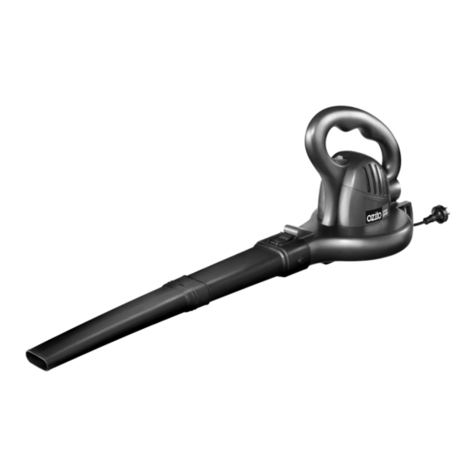
Ozito
Ozito OZBL1800WA Operation manual
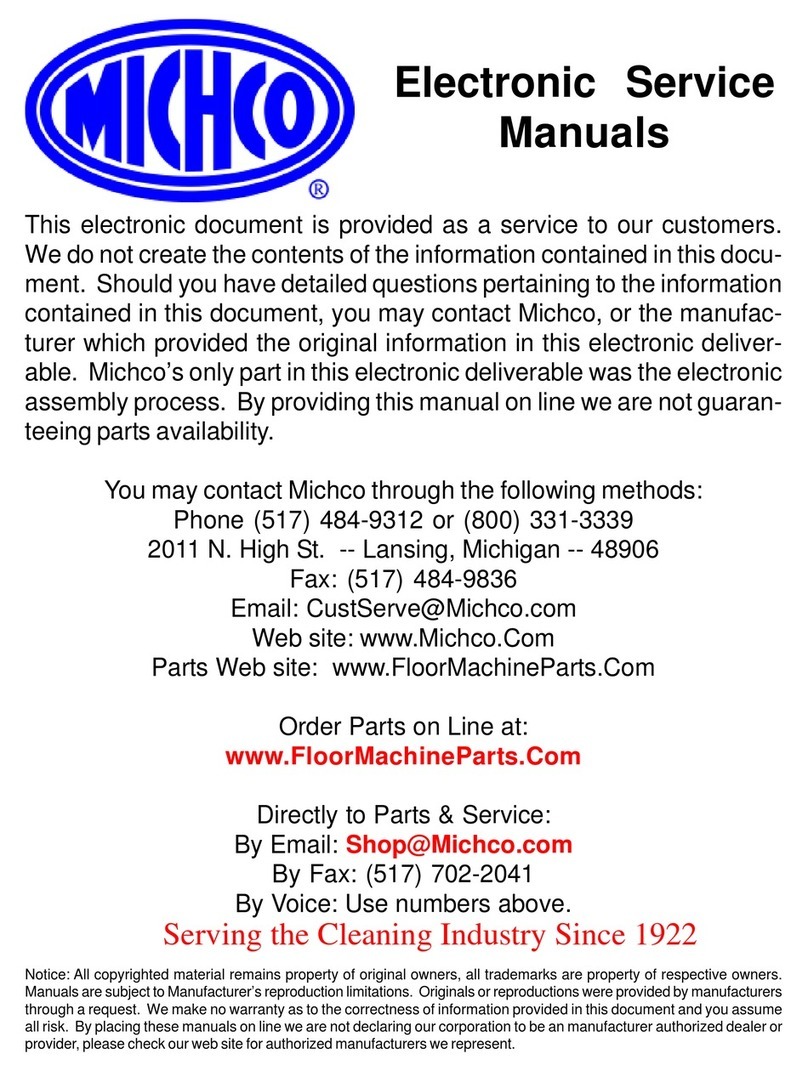
SSS Siedle
SSS Siedle PUMA X 3-SPEED AIR MOVER owner's manual
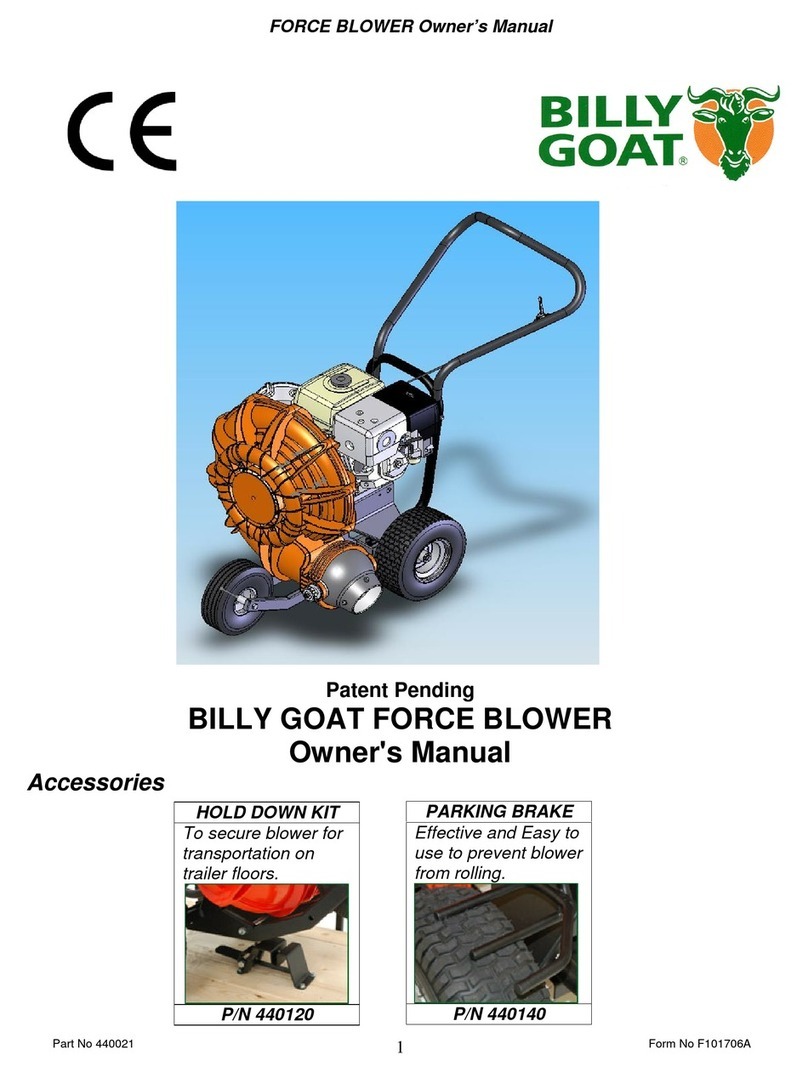
Billy Goat
Billy Goat P / N 440120 owner's manual
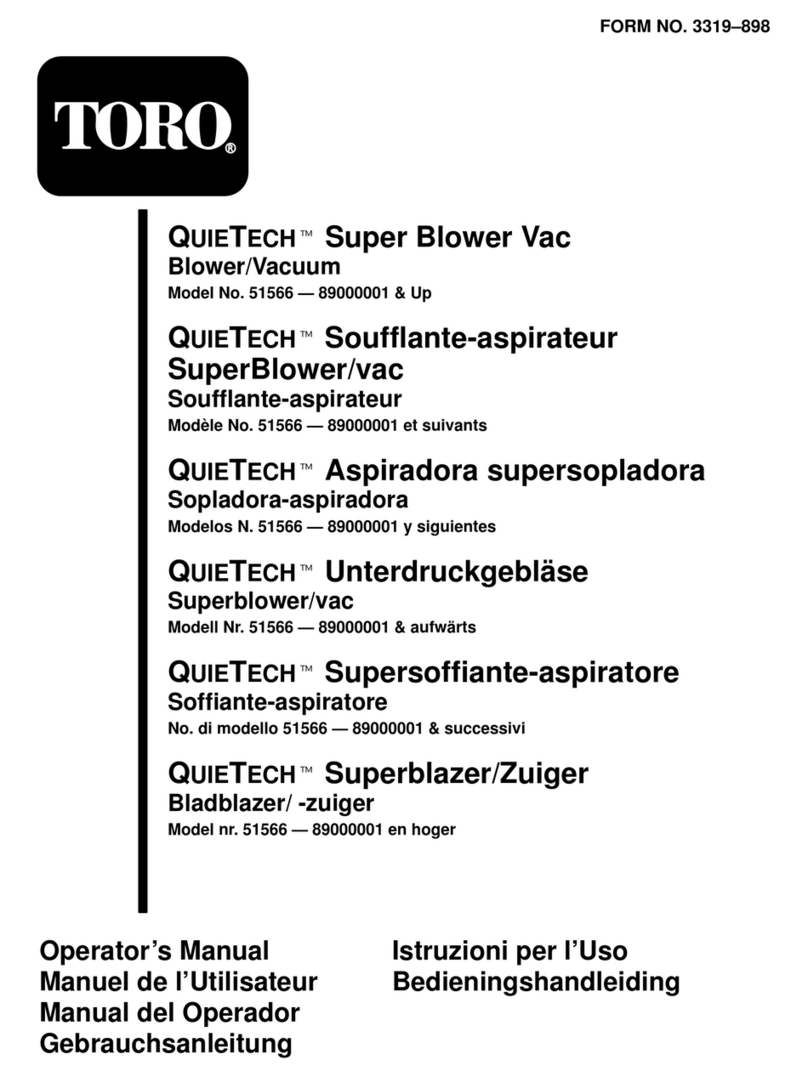
Toro
Toro QUIETECH 51566 Operator's manual
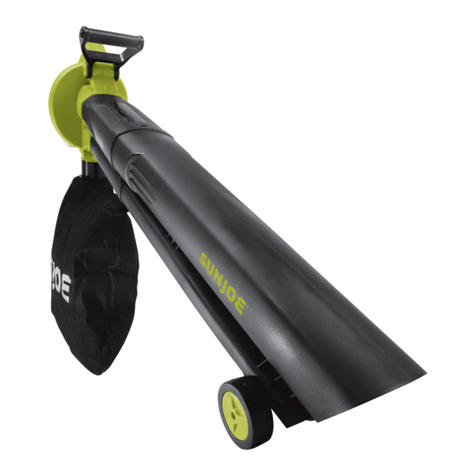
SNOWJOE
SNOWJOE SUNJOE 24V-X2-BVM143-CT owner's manual

STERWINS
STERWINS YT6201-13 Assembly, Use, Maintenance Manual

